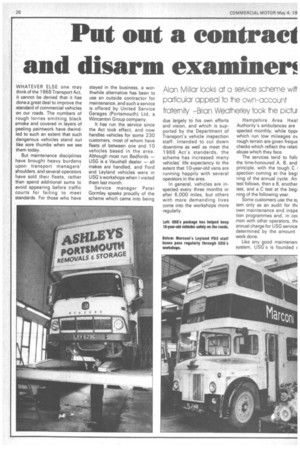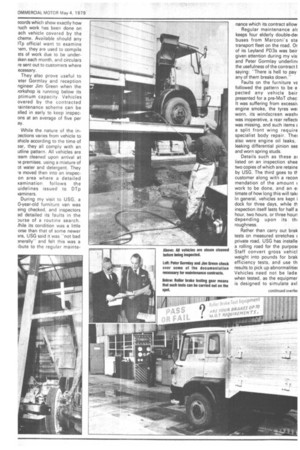Put out a contract and disarm examiner!
Page 28

Page 29

Page 30

If you've noticed an error in this article please click here to report it so we can fix it.
Alan Millar looks at a service scheme wit. particular appeal to the own-account fratern.rty -Brian Wea erley took ne oictur
WHATEVER ELSE one may think of the 1968 Transport Act, it cannot be denied that it has done .a great deal to improve the standard of commercial vehicles on our roads. The numbers of rough lorries emitting black smoke and covered in layers of peeling paintwork have dwindled to such an extent that such dangerous vehicles stand out like sore thumbs when we see them today.
But maintenance disciplines have brought heavy burdens upon transport managers' shoulders, and several operators have sold their fleets, rather than spend additional sums to avoid appearing before traffic courts for failing to meet standards. For those who have stayed in the business, a worthwhile alternative has been to use an outside contractor for maintenance, and such a service is offered by United Service Garages (Portsmouth) Ltd, a Wincanton Group company.
It has run the service since the Act took effect, and now handles vehicles for some 230 customers, most of whom have fleets of between one and 10 vehicles based in the area. Although most run Bedfords — USG is a Vauxhall dealer — all makes are handled, and Ford and Leyland vehicles were in USG's workshops when I visited them last month.
Service manager Peter Gormlay speaks proudly of the scheme which came into being due largely to his own efforts and vision, and which is supported by the Department of Transport's vehicle inspection staff. Intended to cut down downtime as well as meet the 1968 Act's standards, the scheme has increased many vehicles' life expectancy to the extent that 10-year-old vans are running happily with several operators in the area.
In general, vehicles are inspected every three months or after 6,000 miles, but others with more demanding lives come into the workshops more regularly. Hampshire Area Heal Authority's ambulances are spected monthly, while tippf which run low mileages oN, rough terrain are given fregUE checks which reflect the relati abuse which they face.
The services tend to folic the time-honoured A. B, and principle, with the tough C spection coming at the begi ning of the annual cycle. An test follows, then a B, another test, and a C test at the beg, fling of the following year.
Some customers use the s) tem only as an audit for thi own maintenance and inspe tion programmes and, in coi mon with other operators, thi annual charge for USG service determined by the amount work done.
Like any good maintenan, system, USG's is founded ( acords which show exactly how nuch work has been done on iach vehicle covered by the cheme. Available should any )Tp official want to examine lem, they are used to compile sts of work due to be under3ken each month, and circulars re sent out to customers where ecessary.
They also prove useful to 'eter Gormlay and reception ngineer Jim Green when the iorkshop is running below its ptimum capacity Vehicles overed by the contracted laintenance scheme can be ailed in early to keep inspecons at an average of five per ay.
While the nature of the inDections varies from vehicle to ehicle according to the time of ear, they all comply with an utline pattern. All vehicles are team cleaned upon arrival at )e premises, using a mixture of ot water and detergent. They -e moved then into an inspecon area where a detailed xamination follows the uidelines issued to DTp xaminers.
During my visit to USG, a 0-year-old furniture van was eing checked, and inspectors ad detailed its faults in the nurse of a routine search. Mile its condition was a little .orse than that of some newer )ns, USG said it was not bad anerally' and felt this was a ibute to the regular mainte nance which its contract allow
Regular maintenance al: keeps four elderly double-de' buses from Marconi's sta transport fleet on the road. Or of its Leyland PD3s was beir given attention during my vis and Peter Gormlay underlini the usefulness of the contract t saying: "There is hell to pay any of them breaks down."
Faults on the furniture vz followed the pattern to be e pected any vehicle beir presented for a pre-MoT chec It was suffering from excessi% engine smoke, the tyres wei worn, its windscreen washi was inoperative, a rear reflect, was missing, and such items a split front wine require specialist body repair. Thei also were engine oil leaks, leaking differential pinion sea and worn spring studs.
Details such as these ai listed on an inspection shee two copies of which are retaine by USG. The third goes to if customer along with a recon mendation of the amount work to be done, and an ei timate of how long this will talo In general, vehicles are kept i dock for three days, while tti inspection itself lasts for half a hour, two hours, or three hour: depending upon its thi roughness.
Rather than carry out brak tests on measured stretches private road, USG has installe a rolling road for the purpos( Staff convert gross vehicl weight into pounds for brak efficiency tests, and use th results to pick up abnormalitie: Vehicles need not be lade when tested, as the equipmer is designed to simulate axl loads.
Now that tachographs are on the point of becoming compulsory equipment, USG's customers will be relieved to know that they are being phased into the contracted maintenance programme.
Calibration equipment has been installed, and the company is already becoming experienced in the repair of the devices. It knows of operators' experiences with premature cable failures, and is countering this by using longer cables and a more acceptable consistency of lubricant in the spindles.
The scheme is completed by the follow-up documentation which helps keep operators working within the law. Jim Green arranges for plating test applications to be sent out direct from USG upon customers' behalf, and organises a simulated test upon a vehicle once the Driver and Vehicle Licensing Centre at Swansea fixes a date for the real thing. Usually, the DVLC takes about three weeks to process test applications.
All too often, operators neglect trailers, even though they subject tractive units to full-scale examinations. USG tries to discourage this by including trailers in the contracted maintenance package, but finds still that some customers are less willing to send them in.
This may be because trailers are used less intensively, but it is as easy to get a GV9 for a trailer as it is for a tractive unit or a rigid lorry. And that GV9 could be the one which puts an end to an operator's licence.
USG's scheme appeals particularly to own-account operators for whom transport is a means towards an end, and whose energies are concentrated best on more productive channels. They welcome the fact that their vehicles are in experts' hands and are happy to keep their transport manager's responsibilities to a minimum..
There is also a spin-off to USG, as customers tend to buy Bedfords as a result of the services offered, and many no doubt see the contracted maintenance service as a useful continuation of the warranty service offered when their vehicle is new.
More generally, contracted maintenance — whether provided by USG or anyone else of similar repute — is something . which the cost-conscious operator should consider. A fleet of five lorries hardly justifies the full-scale facilities it deserves when the work can be done more efficiently elsewhere.
























































































































